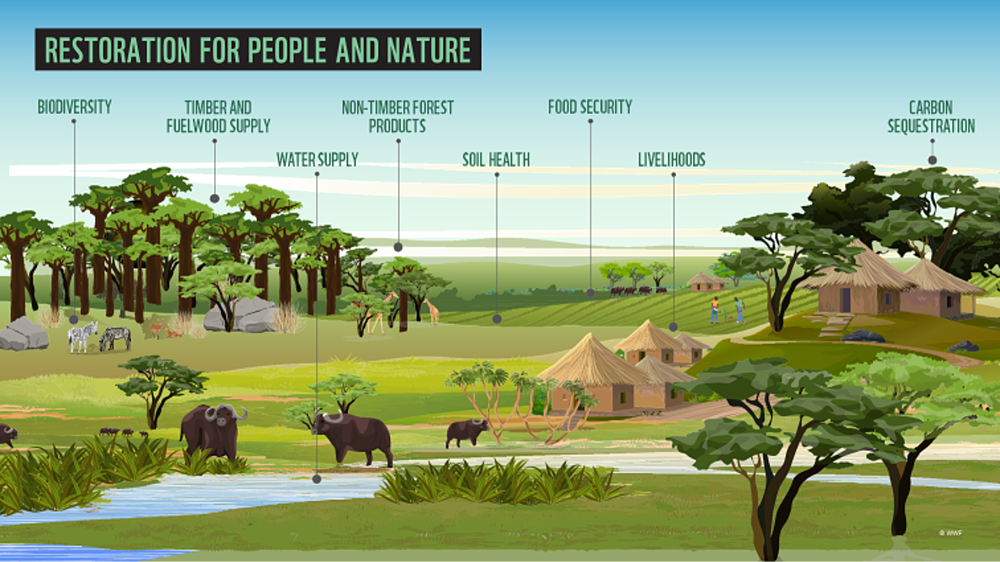The WWF is run at a local level by the following offices...
- WWF Global
- Adria
- Argentina
- Armenia
- AsiaPacific
- Australia
- Austria
- Azerbaijan
- Belgium
- Bhutan
- Bolivia
- Borneo
- Brazil
- Bulgaria
- Cambodia
- Cameroon
- Canada
- Caucasus
- Central African Republic
- Central America
- Central Asia
- Chile
- China
- Colombia
- Croatia
- Democratic Republic of the Congo
- Denmark
- Ecuador
- European Policy Office
- Finland

To me, Forest and Landscape Restoration (FLR) has always meant setting up and nurturing tree nurseries, planting the seedlings in target areas and restoring deforested and degraded lands. A simple but noble mission to mitigate the destruction caused by unsustainable economic development activities such as agriculture, illegal logging and in some cases, artisanal mining.
But boy was I wrong – it is so much more! FLR is an initiative to not only restore degraded and deforested landscapes, but also enhance food security, increase climate change resilience and mitigation, and combat rural poverty.
In Africa alone, 32 countries pledged to bring 128 million hectares under restoration by 2030 as part of the African Forest Landscape Restoration Initiative (AFR100). The UN has also declared 2021 – 2030 as the “Decade on Ecosystem Restoration'' and WWF has joined forces with Trillion Trees, the Finish Embassy, RESTOR, the CARE-WWF Alliance and other implementing partners to launch the FLR in Africa Initiative.
I know what you’re thinking: why such big commitments? I found out it is because we are losing precious biodiversity at an alarming rate – almost 4.4 million hectares of forest is lost in Africa per year and 65% of productive land in Africa is degraded. This means the livelihoods of 90% of Africa’s population – which largely depends on goods and services (such as firewood, charcoal and even medicine) from forests and other ecosystems – are compromised and at stake.
There is undoubtedly an urgent need for action to restore our planet’s health!

I was delighted to attend the FLR in Africa Initiative planning workshop and Tanzania chapter launch in Dar es Salaam, this past June 2022, and learn about how the initiative aims to support the restoration of 13.5 million hectares of degraded and deforested landscapes across nine African countries by 2027. Led by Dr Severin Kalonga, the initiative will work to engage the nine WWF offices in Africa and beyond to empower and enable national and regional governments to deliver their AFR100 commitment in a just way that promotes sustainable livelihoods for local people and biodiversity, putting people and nature at the forefront of the initiative’s work.
The workshop and launch were attended by FLR focal points from the nine WWF offices – Cameroon, Democratic Republic of Congo (DRC), Kenya, Madagascar, Mozambique, Tanzania, Uganda, Zambia and Zimbabwe. In addition, BENGO project focal points from Kenya, Tanzania and Zambia also graced the workshop and launch. Representatives from WWF International, WWF Forest Practice Core Team and Regional Office of Africa (ROA), WWF UK and WWF Germany were also present throughout the week, as well as Trillion Trees and RESTOR. It was great company and a once-in-a-lifetime opportunity for these experienced minds to discuss, and at many times, debate matters relating to previous, ongoing and future FLR interventions.

As a communications personnel, the workshop and launch were extremely insightful – but the highlight of the week was the field visit to BENGO project areas in Kilwa, Lindi district in southern Tanzania. The BENGO project, coordinated by WWF’s Jana Kanig, is a FLR initiative implemented by WWF offices in Tanzania, Kenya and Zambia and partner CSOs in each country to address the threat to biodiversity and steady decrease of ecosystem services and sustainable development opportunity for people. By directly targeting 13 communities highly dependent on natural resources for survival and subsisting on agriculture with low levels of income, the project supports sustainable, climate-smart agriculture and promotes eco-tourism in the culturally and historically rich district.
During our field trip, we visited Mchakama village in Kilwa and spoke with community members about the training and experience they have received through the BENGO project. We also visited a sunflower farm and got a chance to see their seed-oil processing machine that has allowed them to tap into available markets and bridge the revenue gap between selling seeds and selling processed oil.
In a previous trip to Mchakama village, I was also afforded the opportunity to go on a nature hike into their village forest reserve and visit their majestic hidden caves – decorated by breathtaking stalactites and stalagmites. The caves historically served as refuge during tribal wars aimed at raiding villages to capture slaves who would be transported to the Kilwa islands, and later Zanzibar, to be sold off. The caves are therefore considered a sacred and important part of Kilwa’s history, and protected with the same passion as their precious forests. WWF Tanzania’s Azaria Kilimba shared, during this excursion, how the BENGO project is supporting the village to develop nature trails and eco-tourism brochures for marketing, as well providing training to local youth tour guides.
The whole experience was extremely eye-opening and really drove home the message of how essential it is to support local communities as they protect and conserve their precious natural resources. It was lovely to see the participants from other countries discuss what they had learnt throughout the week at the FLR workshop, launch and field trip. The strengthened inspiration and commitment to this cause was undeniable and I believe we all ended the week feeling determined in the roles we play in restoring the earth back to health.

